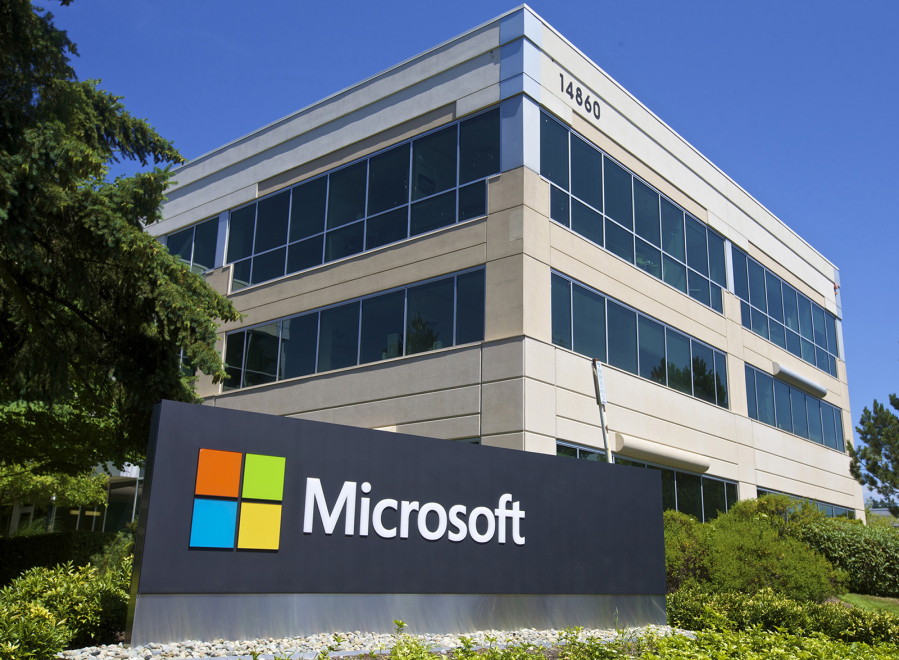SEATTLE — When Microsoft first started to build its Redmond campus in the 1980s, it used three things to entice workers: free soda, a lax dress code and private offices.
As it scaled up, it prioritized those offices and designed star-shaped buildings to get as many window seats as possible. Now, in the age of the open floor plan, the sodas and flip-flop dress code have stayed but the offices are changing.
“As our teams were coming in, thinking about collaborative workspaces, there was very little we could do with [the original buildings],” said Rob Towne, senior director of real estate for Microsoft’s Puget Sound region. “So they decided to tear them down.”
Microsoft is in year eight of a nearly 10-year project that saw it demolish 12 buildings to create 17 new ones, along with sports fields and a thermal energy center that powers its offices using heat from the Earth.
Microsoft started planning in 2015 and demolishing buildings in January 2019. Now, it’s gearing up to open the first of the new buildings in 2023, beginning a nine-month rollout.
Towne said it was a multibillion-dollar project but could not disclose the specific cost. At its peak, there will be about 3,000 construction workers on site.
“We want to create a space where people are really encouraged,” said Allen Nichols, director of development for the Puget Sound region. “We want to attract our employees to want to come to campus, to understand all the different flexible ways they can work and collaborate in the space and really draw people in.”
Microsoft fully reopened its offices at the end of February with a hybrid work model.
The new construction sits on a 72-acre plot, part of Microsoft’s 520-acre campus. Looking at a model, Towne said “you can see the shift in our master planning efforts,” moving from a suburban campus with buildings spaced far enough apart to fit at least two lanes of cars to a dense, urban environment served by walking paths.
The new buildings are only four or five stories high, a nod toward the company’s residential neighbors, Towne said.
The construction project includes a pedestrian bridge to help workers cross the campus, an outdoor plaza that can hold 5,000 people — where Microsoft is planning to host all-hands meetings or celebrations for a class of interns — and an underground parking garage. That garage will be equipped with Wi-Fi so workers can use an app developed in-house to help them find a spot.
The campus also includes three new sports fields for softball, baseball and cricket, a favorite of CEO Satya Nadella.
Underneath the fields sit roughly 900 wells, part of Microsoft’s new thermal energy center, which generates power for the buildings on campus using those wells, tunnels and storage tanks.
“Sustainability is just the price of entry these days, but we need to figure out how to do it better,” Towne said.
Just as water is moving underground, Microsoft is also turning to tunnels to help get deliveries to the right building. The underground “back-of-the-house” logistics hub includes a 30,000-square-foot kitchen and a network of tunnels that reach each building for deliveries.
Right now, humans help move the goods through that network. But Towne and Nichols said the company has its eye on self-driving tech in the future to help make the process more efficient.
Microsoft has roughly 50,000 people working in the Puget Sound area, and occupies 14 million square feet in the region. It has 120 buildings, and 75 of those locations are devoted to offices.
The Redmond campus is “a city in itself,” said Brian Collins, director of global workplace services.
Those offices once included four design elements: individual offices, corridors, kitchenettes and conference rooms.
Now, Microsoft designs “neighborhoods” that group teams of workers together, allowing some to choose a permanent spot and some to reserve desk space on an as-needed basis.
A new building for the marketing team, which Microsoft opened five weeks ago, has game rooms with Xboxes on one floor and air hockey on another, as well as several relaxation rooms, where workers can find a quiet place to work or a dark place to nap.
Borrowing a phrase from CEO Nadella, Collins said the design shift has moved Microsoft from a “know-it-all” culture — where teams worked apart from one another and coworkers couldn’t benefit from brainstorming or other conversations that they simply overheard — to a “learn-it-all” mindset.
During the design process, Towne said there were a lot of emotions about moving away from the star-shaped buildings that prioritized privacy and space. People asked if they could save one building and memorialize it as a museum — or at least save co-founder Bill Gates’ office.
But Microsoft is already starting to design for the next generation of workers, according to Scott Weiskopf, director of the company’s Center for Innovation.
Standing in The Hive, a nondescript building about 5 miles from Microsoft’s Redmond hub where researchers plan and test new office designs, Weiskopf said his team is trying to understand how people will live and work in the future, in the physical, digital and cultural sense.
“So that kid who’s in high school, who’s going to be our employee, when they get here, how does it seem perfect to them?” Weiskopf said. “It’s fascinating because you want to skate to where the puck is going, but nobody’s sure where the puck is going.”




